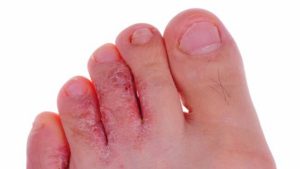Stop Athlete’s Foot This Summer!
December 10, 2017
 Summer is here (yay!) and that means sunshine, warm days and spending lots of time outdoors. This is also a time where we do see a lot of patients with Athlete’s Foot, which is clinically known as tinea pedis. There are two main reasons that we see if often around now:
(1) is that fungus thrives in warm, moist conditions – and it’s pretty warm outside so our feet tend to sweat, and
(2) is that because we wear more open-toed shoes, those that have been hoping that it’ll settle and resolve over the winter are now starting to feel a little more self-conscious and decide that it’s time to take action.
Either way, or whatever your reason, your Podiatrist is definitely the right place to get rid of it once and for all.
Summer is here (yay!) and that means sunshine, warm days and spending lots of time outdoors. This is also a time where we do see a lot of patients with Athlete’s Foot, which is clinically known as tinea pedis. There are two main reasons that we see if often around now:
(1) is that fungus thrives in warm, moist conditions – and it’s pretty warm outside so our feet tend to sweat, and
(2) is that because we wear more open-toed shoes, those that have been hoping that it’ll settle and resolve over the winter are now starting to feel a little more self-conscious and decide that it’s time to take action.
Either way, or whatever your reason, your Podiatrist is definitely the right place to get rid of it once and for all.
So, what exactly is Athlete’s Foot?
Athlete’s foot describes a fungal skin infection that is actually relatively common. It’s common because it’s very contagious and it only takes sharing a shower or a surface (especially gyms, locker rooms and anywhere warm and damp) to become infected yourself. If it infects the nails, it can become very difficult to manage.What are the symptoms?
If you have contracted Athlete’s Foot, you’ll experience:- Itching
- Red scaly patches on the skin of the feet that seems dry
- Stinging or burning
- Breakdown of the skin between the toes that may present as cracks or fissures
How do you treat it?
The first step in managing and eliminating Athlete’s Foot is to have a correct diagnosis from your Podiatrist. Once you’re sure it’s a fungus, you should be doing as much as you can to keep the feet dry, clean, and away from sources of infection. These typically include:- Keeping the feet dry
- Using absorbent powders if your feet sweat excessively
- Disinfecting infected shoes and socks to demote reinfection
- Wearing absorbent socks that will promote a dry environment
- Wearing open shoes where possible to let the feet air and dry
